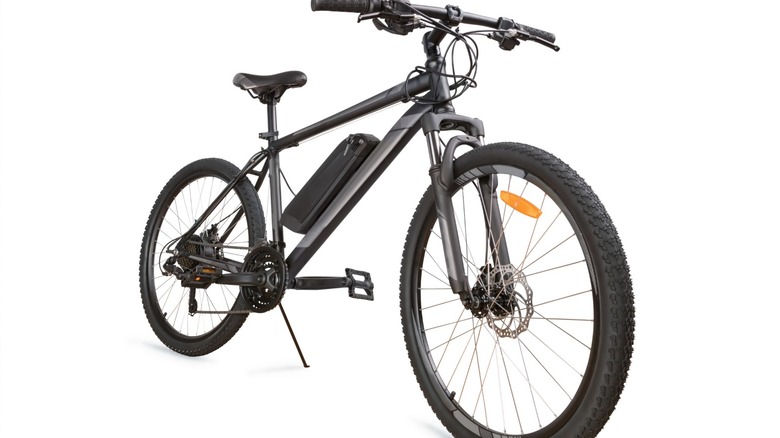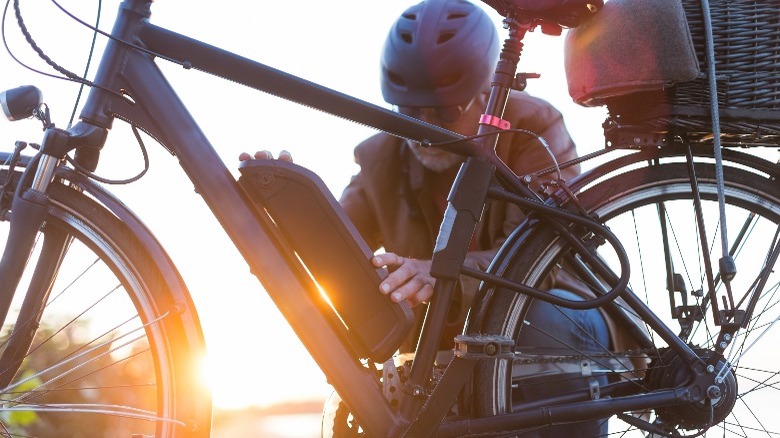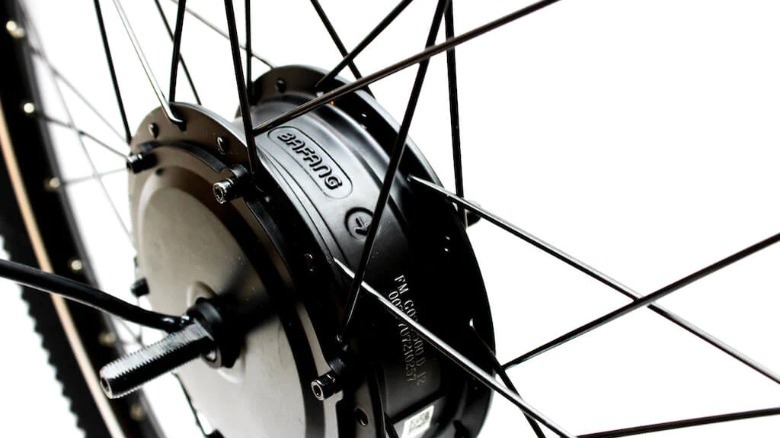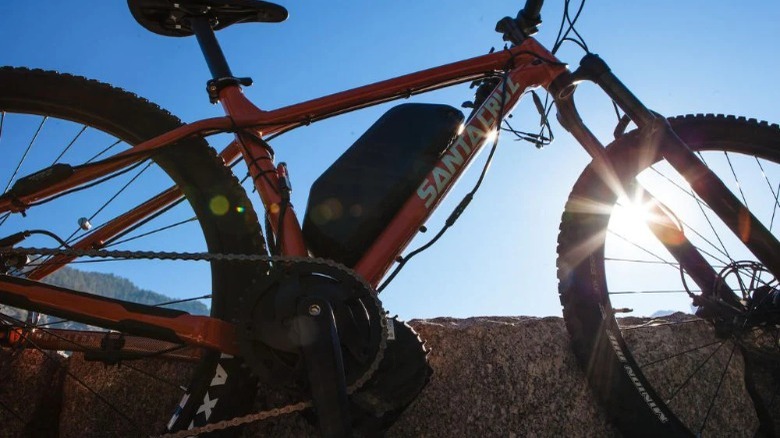How You Can Turn Your Bicycle Into An E-Bike
While the electric motorcycle market is still in a somewhat odd position with many of the best options not quite having what it takes to seriously compete with gasoline contemporaries, the electric bicycle scene is booming. eBicycles reported that the market is expected to see around 50% growth from 2022 to 2023. Dominant manufacturers have joined the fray. The only problem is price — even low-to-mid-range hard-tail e-bikes like the Giant Talon E+ 3 costing well over $2,000.
The solution might be found in the DIY market. While a production e-bike, like the aforementioned Talon E+ 3, delivers 250 watts of electric pedal-assisted power, you can get a 750-watt Bafang mid-drive kit for around $800 — and potentially less from Amazon. With a kit like that, you can either upgrade your existing bicycle or source the rest of the materials to build one from scratch.
At this point, you might be thinking to yourself that building an e-bike might be a bad idea — after all, as Sinar ebikes reports, some e-bike builds can reach speeds in excess of 30 mph. Like most things in life, knowledge is power, and knowing what to do and what not to do is key to building a safe DIY e-bike.
Tips about e-bike conversion kits
At the most basic level, an e-bike consists of four parts — the battery, brakes and frame. Most systems come with additional parts, like pedal sensors, throttles and display units, but not necessarily all of them do. When you buy a kit, make sure that all the parts are included. While you can easily buy any missing pieces, anything that's not included could be a compatibility nightmare.
On the topic of compatibility, there are two main variations of conversion kit: Hub and Mid-Drive (via Elektrek). Each has its own advantages and disadvantages, but the differences mostly come down to where the motor goes. Mid-drive motors attach to the bicycle frame through the bottom bracket — where the crank shaft attaches — and allow the motor to interface directly with the bicycle's original rear-wheel-mounted transmission system. Hub motors, on the other hand, are motors encased in the hub of either the front or rear wheel — or sometimes both.
While both hub motors and mid-drives connect to a battery pack and a controller, that's about where the similarities end. Deciding which motor type is right for you depends entirely on two things — your intended use case, and how handy you are with a wrench.
Hub motors excel thanks to their simplicity
As Elektrek explains, the main benefits of hub motors stem from their simplicity and self-contained nature. While some higher-end hub motors do come with planetary gears to increase efficiency, most are direct drive, making them dead simple and low-maintenance. When you pedal or apply the throttle, the motor applies a fixed level of assistance, and when you release the throttle or stop pedaling, the motor disengages. There is generally no variation in the amount of torque or power aside from changing assistance mode.
The mounting location of hub motors can present issues, though. On the one hand, adding weight to the wheels hurts handling and limits their use to on-road commuter bikes in more than one way. Less importantly, unsprung mass bypasses any suspension the bike may have, potentially making any off-road riding feel bumpier (via Cycle World). Secondly, the increase in rotational mass means hub motors — especially mounted to the front wheel — can cause handling to feel less responsive (via Bosch). Lacking gearing, hub motors also perform less admirably than mid-drives when climbing or at low speed. On the more practical side of things, hub motors can limit your selection of rims, tires, and cassettes. If you plan on getting rowdy, a hub motor might not be the best bet, since tougher rims are usually aftermarket upgrades. The same rings true for gearing — hub motors are often too wide to support cassettes with many gears, limiting the types of terrain you can tackle.
If you're looking for a cheap commuter to run around town and get to work and back, a hub motor will do you just fine, but if you want something more, a mid-drive is better.
Mid-drives are better for flexibility
Every electric system you put on a bicycle is going to add weight. Mid-drive motors mitigate the effects of that extra weight because the added weight is sprung mass, and there is no extra rotational mass (via CJ Pony Parts). Mid-drive motors also benefit from the transmission system on a standard mountain bike. Since the chain runs from the motor output to the rear transmission, any force applied by the motor receives the same mechanical advantage as pedaling would. The motor acting through the gears on the rear wheel makes a mid-drive far more versatile. If you're on a steep hill, you can shift into a lower gear to get more torque, and if you're on a flat, you can shift into a higher gear for more speed — all without sacrificing efficiency of the motor.
Mid-drive motors aren't perfect, though, and the main drawback is that they require a bit more mechanical know-how than a hub motor. For starters, there's often a little more setup required. Instead of simply slotting in a new wheel, attaching a chain, and connecting the wires, mid-drives also require removing the bottom bracket and replacing it with the motor — a task that requires a special bottom bracket removal tool. Mid-drives also increase drivetrain wear, meaning replacement parts will be in order sooner (via Electric Travel).
While mid-drive motors take home the win in terms of efficiency and performance, hub motors are a neat package, and are often more than enough for the average commuter e-bike. Mid-drive motors also lose the cost competition in a bad way. While the aforementioned 1000 W Bafang mid-drive motor kit came in at around $530, a similar hub motor kit comes in at around $370. The penalty of mid-drive performance is cost and complexity.
The technicalities and legalities of e-bikes matter
Building a DIY e-bike isn't incredibly difficult, but you need to make sure your parts all coalesce. It might be tempting to cheap out and shove a 750 watt mid-drive motor onto a $100 bicycle from Craigslist, but remember that the added weight, speed, and power put additional strain on the components. If you're looking for a budget option for a mid-drive conversion, used downhill mountain bikes are a good place to start shopping.
Aside from the practicality and motor choices, there are local laws and regulations that you need to consider before committing to a build. According to Juiced Bikes, 36 U.S. states place e-bikes into three distinct classes. Class 1 e-bikes are pedal-assist only with a speed limit of 20 mph. Class 2 allows for a throttle-only mode, but retains the 20 mph speed limit from Class 2. Class 3 does away with the throttle-only mode, offering only pedal assistance, but allows for a maximum speed of up to 28 mph. While less common, you may need to register your e-bike as a motorized vehicle, and there may be other limitations on age and motor output. For instance, New York State imposed a 750 watt limit on e-bikes throughout the state, meaning anything more potent needs to be registered, and you need a license to operate it.
Factory-assembled options are often simpler than the DIY route, but do the due diligence and building your own e-bike can be rewarding and fun.




